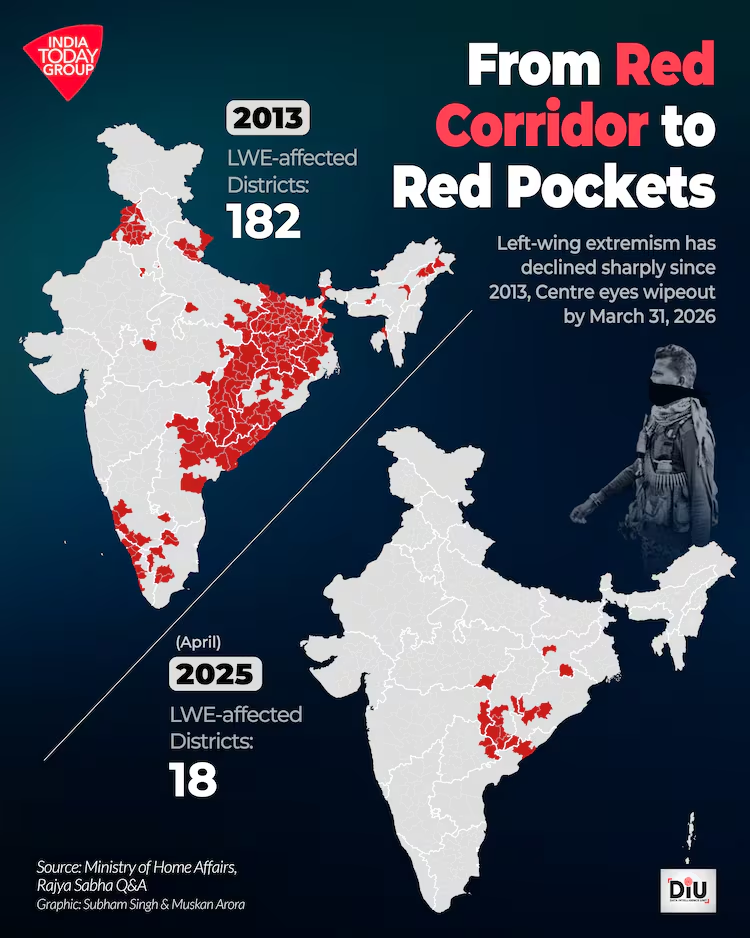



Copyright infringement not intended
Picture Courtesy: INDIAN EXPRESS
The Maoist insurgency in India, once peaking in the 2000s, is in decline due to persistent security operations, declining recruitment, aging leadership, and tribal communities’ growing integration with development schemes.
Origin (1967)
The movement traces its roots to a peasant and tribal uprising in Naxalbari village, West Bengal, led by Charu Majumdar, Kanu Sanyal, and Jangal Santhal against local landlords. This sparked the formation of the Communist Party of India (Marxist-Leninist) [CPI(ML)] in 1969, which advocated for armed revolution.
Ideology
Influenced by Maoist thought, Naxalism believes in class conflict and a "protracted people's war" to violently overthrow the state, which it views as feudal and imperialist.
Resurgence and Consolidation (1980-2004)
After being suppressed in the 1970s, the insurgency was revived by groups like the People's War Group (PWG) in Andhra Pradesh. They expanded their influence across central and eastern India, creating the "Red Corridor."
Peak and Decline (2004-Present)
The merger of major factions in 2004 to form the powerful CPI (Maoist) marked the insurgency's deadliest phase. By the late 2000s, violence spanned nearly 180 districts. However, a sustained government strategy has led to a decline since 2010.
Violence Incidents
Incidents of Naxal violence fell by 81% from a peak of 1,936 in 2010 to 374 in 2024.
Total deaths (civilians and security forces) dropped by 85%, from 1,005 in 2010 to 150 in 2024.
Geographical Spread
Number of districts affected by LWE has shrunk from 182 in 2013 to just 18 as of April 2025. The number of 'most-affected' districts is down to just six.
The Union Home Minister has set a target for completely eliminating Naxalism by March 31, 2026.
 Root Causes of Naxalism in India
Root Causes of Naxalism in IndiaAgrarian Distress and Land Alienation
Naxalism succeeds on grievances related to 'Jal, Jangal, Jameen' (Water, Forest, Land). Decades of inadequate land reforms, displacement due to mining and industrial projects without proper rehabilitation, and weak implementation of forest rights laws have fueled a deep sense of injustice among tribal and landless communities.
Governance Vacuum
This vacuum, marked by administrative apathy, corruption, and exploitation by officials and contractors, allowed Naxals to establish a parallel system of governance and justice (Janatana Sarkars).
Poverty and Lack of Economic Opportunities
The regions most affected by LWE are home to India's poorest populations. The lack of education, skills, and employment makes youth vulnerable to recruitment by Naxalite groups who promise empowerment and social justice.
SAMADHAN Strategy to combat Left-Wing Extremism (LWE)
Zero-Tolerance Approach
A persistent security crackdown has dismantled the Naxal hierarchy. Since 2019, 280 new security camps have been established in remote areas, choking supply lines and liberating former strongholds.
Force Modernization
Specialized forces like the COBRA commandos and state-level forces like the Greyhounds (Andhra Pradesh) have been conducting precise, intelligence-based operations.
Choking Finances
The National Investigation Agency (NIA) and Enforcement Directorate (ED) are disrupting Naxal funding networks that rely on extortion and illegal mining.
Infrastructure Connectivity
Roads: Projects like the Road Requirement Plan-I (RRP-I) have accelerated road construction, improving access for both security forces and development agencies.
Telecom: Government aims to equip the entire Naxal-affected region with 4G mobile connectivity by December 1, 2025, connecting once-isolated youth to the digital world.
Welfare and Empowerment
Education: Over 178 Eklavya Model Residential Schools have been established in tribal blocks to provide quality education.
Skill Development: Programs like the ROSHNI scheme provide vocational training to youth, with 48 Industrial Training Institutes (ITIs) and 61 Skill Development Centres (SDCs) now functional in LWE-affected areas as of May 2025.
Financial Inclusion: Thousands of new bank branches, ATMs, and post offices have been opened to ensure direct benefit transfers and reduce dependence on exploitative moneylenders.
Winning Hearts and Minds
The Civic Action Programme (CAP) by security forces helps build trust through medical camps and sports events. The Aspirational Districts Programme fast-tracks development in the most backward districts, including those affected by LWE.
Difficult Terrain
Naxalites continue to exploit dense, inaccessible forests like Abujhmad in Chhattisgarh, which create logistical challenges for security forces.
Governance Deficit
While improving, the state's administrative machinery is still weak in many core areas. Ensuring the corruption-free, last-mile delivery of welfare schemes remains a challenge.
Human Rights Dilemma
Security operations must be conducted with precision to avoid alienating local populations. Past instances of alleged extrajudicial actions have fueled mistrust and been exploited by Naxal propaganda.
Urban Naxalism
The ideology continues to find resonance among certain intellectual and activist networks in urban areas, creating a new front in the ideological battle.
Sustain Security Pressure
Continue intelligence-led, precise operations to neutralize the remaining leadership, while strengthening inter-state coordination to prevent Naxals from escaping across borders.
Accelerate and Deepen Development: The focus must be on empowering local communities.
Strengthen Community Policing
Build trust through participatory governance and responsive local administration. Successful community policing models, like in Gadchiroli, Maharashtra, should be replicated.
Promote Effective Surrender Policies
Continue to offer attractive rehabilitation packages to capitalize the collapsing morale within Naxal ranks and provide a pathway back to the mainstream. Over 8,000 Naxalites have surrendered in the last 10 years.
The decline of Maoist extremism proves security alone is insufficient; lasting peace comes from inclusive development—roads, schools, healthcare, and justice—ensuring marginalized communities share in growth and governance, weakening roots of Left-Wing Extremism.
Source: INDIAN EXPRESS
|
PRACTICE QUESTION Q. Developmental deficits, rather than ideological motivation, are the main reason for Left-Wing Extremism (LWE). Critically Analyze |
LWE refers to armed insurgencies inspired by Marxist-Maoist ideology (often called “Naxalism”), seeking to overthrow the existing state through guerrilla warfare, drawing support from disaffected rural/tribal populations.
It has been strongest in the so-called “Red Corridor” — parts of central, eastern, and southern India: Chhattisgarh, Jharkhand, Odisha, parts of Maharashtra, Andhra Pradesh, Telangana, Bihar etc.
Key causes include: economic inequality; lack of infrastructure; displacement due to mining/industrial projects; poor access to education, healthcare; weak governance and justice; alienation of tribal and forest-dwelling communities.
© 2025 iasgyan. All right reserved